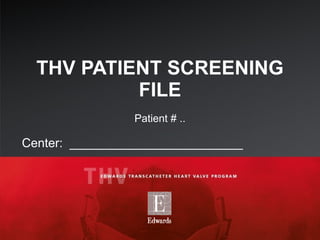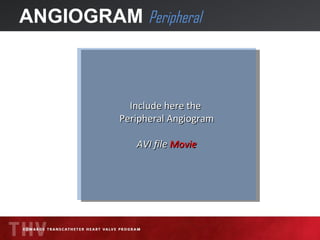Thv patient screening template
- 1. THV PATIENT SCREENING FILE Patient # .. Center: _________________________
- 2. INSTRUCTIONS FOR USE 1/2 Please make a copy of this file for every patient Provide as much data as possible (see slides) Please incorporate the movies into the presentation as shown. (bring DICOM CDs with it) Bring the data on a CD or USB stick to the training To enter patient data (slide 5, 6, 7 and 8) go into edit mode PowerPoint. To click the boxes (see slide 7) go into presentation mode
- 3. INSTRUCTIONS FOR USE 2/2 Helpful tool for Windows users is the ŌĆ£Snipping ToolŌĆØ Where you can easily make pictures from your screen Via START button->All Programs->Accessories See example
- 4. CRITERIA INDICATIONS Symptomatic Degenerative Aortic Stenonosis AVA Ōēż 0.8cm2 Logistic Euroscore > 20% or STS > 10% www.euroscore.org/calc.html http://209.220.160.181/STSWebRiskCalc261 ANNULUS BY TEE 18 to 21mm -> 23mm SAPIEN 21+ to 24.5mm -> 26mm SAPIEN
- 5. CRITERIA Non-valvular aortic stenosis Congenital aortic stenosis, unicuspid or bicuspid aortic valve Non-calcified aortic stenosis Evidence of intracardiac mass, thrombus or vegetation Untreated clinically significant coronary artery disease requiring revascularization Active bacterial endocarditis or other active infections Myocardial infarction within 1 month Cerebrovascular accident (CVA) Patient unable to tolerate anticoagulation therapy Hypertrophic cardiomyopathy with or without obstruction (HOCM) Presence of mitral bioprosthesis Severe ventricular dysfunction with ejection fraction < 20% Severe deformities of the chest Severe coagulation problems Unstable angina during index procedure Recent pulmonary emboli Recent Significant atheroma of femoral and iliac vessels Severe tortuosities of the femoro -iliac vessels Severe calcifications or femoro -iliac vessels < 7mm Patients with bilateral iliofemoral bypasses CONTRA - INDICATIONS
- 6. PATIENT DATA Echo Evaluation Add text in Edit mode Click boxes in Presentation mode Hospital Name Logisc EuroSCORE / STS Score Subject Initials _____________________________ __ % / __% __ __First/Last If Euroscore < 20% and STS < 10%, COMMENTS: Date of Screening: __/__/____ (dd/mm/yyyy) Subject Gender Female Male Height: Subject Age and birth date ___________________________ Weight: ECHO FINDINGS Annulus ├ś, TTE (mm) (18 to 24) Annulus ├ś, TEE (mm) (18 to 24) AVA (cm 2 ) (< 0.8 cm 2 ) Mean gradient (mmHg) EF (>20%) Calcification degree Septal hyperthrophy Bicuspid/unicuspid aortic valve? AORTOGRAM Calcified bulky leaflets? Distance coronary ostia ŌĆō annulus (Ōēź10mm) Horizontal aorta? Define optimum view (3 leaflets aligned) Porcelain aorta? CORONAR ANGIOGRAM Coronary diseases? Comments: ECG Conduction irregularities Pace Maker AV Block/ RBBB/LBBB Comments
- 7. PATIENT DATA Echo Evaluation Add text in Edit mode PATIENT ŌĆÖS HISTORY , SYMPTOMS, NYHA CLASS ADDITIONAL COMMENTS HELPFUL FOR PATIENT EVALUATION
- 8. PATIENT DATA Peripheral Sizing Add text in Edit mode Click boxes in presentation mode CT Scan (section 5 mm max) Angiogram RIGHT VESSEL SIZE Right Common Femoral Vessel Size > 7.5 mm (Smallest Diameter) YES NO Right External Iliac Vessel Size > 8 mm (Smallest Diameter) YES NO Right Common Iliac Vessel Size > 8 mm (Smallest Diameter) YES NO Tortuosity None Mild Moderate Severe Degree of Calcification None Mild Moderate Severe LEFT VESSEL SIZE Right Common Femoral Vessel Size > 7.5 mm (Smallest Diameter) YES NO Right External Iliac Vessel Size > 8 mm (Smallest Diameter) YES NO Right Common Iliac Vessel Size > 8 mm (Smallest Diameter) YES NO Tortuosity None Mild Moderate Severe Degree of Calcification None Mild Moderate Severe ABDOMINAL AND THORACIC AORTA Aortic Calcification No Yes Aortic Tortuosity No Yes EDWARDS RECOMMENDATIONS Edwards Valve Size: 23mm 26mm Edwards Sheath Access Site: Right Left
- 9. PATIENT DATA Add text in Edit mode Click boxes in presentation mode INVESTIGATOR SIGNATURE Print Name Date __ __ / __ __ / __ __ __ __(dd/mm/yyyy) Email address: CASE APPROVED BY SCREENER Yes No Screener Comments/Explanations SCREENERS SIGNATURE Print Name Date __ __ / __ __ / __ __ __ __(dd/mm/yyyy)
- 10. ECHO Pictures PICTURE 1 LONG AXIS Measurement Nr1 + value PICTURE 2 LONG AXIS Measurement Nr2 + value PICTURE 3 LONG AXIS Measurement Nr3 + value Show annulus measurements -hinge point to hinge point- Include diameter sinuses 3 different measurements PICTURE 4 SHORT AXIS view (Calcium distribution)
- 11. ECHO Movie Echo AVI file Movie Show Echo Movie: Long Axis view 4 Chamber view Short axis view (calcium distribution) Ventricular contraction Mitral Valve apparatus
- 12. AORTOGRAM Picture PICTURE Aortic Root Shot To recognize distance ostia to bottom cusps
- 13. ANGIOGRAM Peripheral Include here the Peripheral Angiogram AVI file Movie
- 14. CT Angio Heart & Peripherals Place PICTURE Aortic Root distance from, Corononary Ostia to bottom cusp Place PICTURE Aortic bifurcation (CT-slice) Both for TA & TF
- 15. CT Angio Heart & Peripherals Place PICTURE Left Side Smallest lumen from Aortic bifurcation to common femoral Place PICTURE Right Side Smallest lumen from Aortic bifurcation to common femoral If available 3D Reconstruction Total Aorta and peripherals pictures Please keep DICOM CT-Angio CD available SPECIFIC FOR TransFemoral CASES Make sure you can recognize calcium differentiating from lumina (greyscaling)
- 16. CORONARY Angiogram Include here the Coronary Angiogram Full coverage standard Coronary Angiogram AVI file Movie
- 17. OUR SUGGESTIONS This Patient will be suitable for TransFemoral or TransApical Comments: ___________________________________________________ Suggested Valve Size: ___ mm
- 18. EXAMPLES IMAGING =>Echo 22mm 23mm ECHO 3x Long Axis Views Measurements (not realistic measurements!) 23mm ECHO Short Axis View
- 19. EXAMPLES IMAGING => Aortogram AORTOGRAM Provides Info on: Angulation Left Main to bottom cusps Diameter Sinusses Porcelain Aorta
- 20. EXAMPLES IMAGING => Aortogram peripherals ANGIOGRAM PERIPHERALS Provides Info on: Tortuosity
- 21. EXAMPLES IMAGING => CT Angio BIFURCATION OSTIA TO BOTTOM CUSPS SMALLEST DIAMETERS 3D RECONSTRUCTION
- 22. GENERAL INFO For coming to the training please bring the Powerpoint Presentations. Make sure you provide as much data as possible If sending data to the proctor (who will attend the implants) also include the CDŌĆÖs with all the files in DICOM format as he/she can re-measure (If you have questions please contact your local Clinical Specialist)
- 23. Thank you!






















